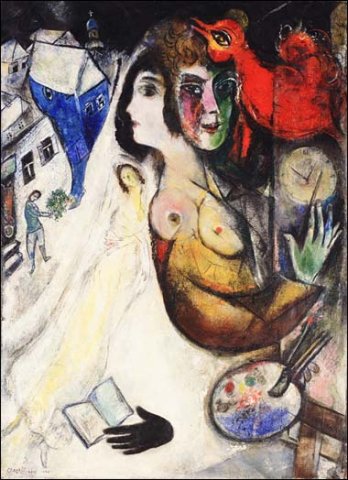Marc Chagall
dal 7/10/2005 al 6/11/2005
Segnalato da
7/10/2005
Marc Chagall
Arken Museum of Modern Art, Ishoj
With more than 180 works spanning all of his work – forty paintings, gouaches and drawings as well as 150 lithographs, etchings and sculptures – this exhibition offers a comprehensive and exclusive vision of his world of love and tolerance. In spite of world wars and persecutions of Jews,Chagall expressed love in his fantastic paintings, stained glass works and book illustrations which all exhibit his tolerance and openness towards different cultural traditions.

World of love
Curator Dorthe Rugaard Jørgensen
This exhibition has been mounted in collaboration with Chagall’s granddaughter Meret Meyer, and some of the major museums in Europe and Russia: Centre Georges Pompidou in Paris, Musée national du Message Biblique in Nice, Sprengel Museum in Hannover and State Tretyakov Gallery in Moscow. Moreover a large number of major works are on loan from private collections. With more than 180 works spanning all of his work – forty paintings, gouaches and drawings as well as 150 lithographs, etchings and sculptures – this exhibition, which will be shown at Arken only, offers a comprehensive and exclusive vision of his world of love and tolerance
Marc Chagall's (1887-1985) love of mankind and of the world pervades ARKEN this autumn. The great Russian-French painter was born into the traditions of Judaism in the small Russian town of Vitebsk. In spite of world wars and persecutions of Jews, throughout his life Chagall preserved his childhood faith that love is present in even the tiniest aspect of the world and must be celebrated with music, joy and beauty.
Chagall expressed love in his fantastic paintings, stained glass works and book illustrations which all illustrate his tolerance and openness towards different cultural traditions, e.g. Jewish, Christian, Muslim and secular. Chagall's pictures brim with musicians and circus performers, religious symbols, memories from Vitebsk and not least his beloved Bella.
A universal, divine factor of life
According to Jewish mysticism the world began its existence as a vessel into which God poured his love. And He filled the vessel beyond its breaking point, shattering it in millions of pieces. Therefore even the most diminutive things in the world hold a spark of divine love. Love, which is ubiquitous, renders everything in life – and thus in art too – poetic, magical and divine. The world was far from ideal to the Jewish-Russian painter. However, with a basis in his own cultural roots, his life and his art nonetheless championed the concept that something binds people together, giving them hope: love. Chagall believed in love as a universal, divine factor of life
From Vitebsk to France
A native of the Jewish community in Belarusian Vitebsk, the desire to become an artist made him immigrate to France in 1911. However, during and after World War I he was forced to return and stay in Vitebsk where he married Bella, the love of his life. In 1923 he travelled back to France and lived there until 1941 when he had to escape to America to avoid the concentration camps. His exile lasted until 1947 when he returned to France, spending the rest of his life there. Only once, in 1973, did Chagall visit his native Russia but he never saw his beloved Vitebsk again.
Builder of bridges
In spite of sorrows and conflicts Chagall exhibited his joie de vivre and love of the world in his art. ARKEN’s exhibition shows how his poetic pictures bridged a wealth of cultures, religious as well as secular. His works brim with subjects from Vitebsk, biblical scenes from the Old and the New Testaments; circus performers and musicians; Jean de la Fontaine’s Fables, Arabian Nights; as well as decorations of synagogues, Catholic churches and various secular institutions.
Image: Marc Chagall Village with a dark sun, 1950
ARKEN MUSEUM OF MODERN ART
Skovvej 100 - Ishoj Denmark
Hours: Open Tuesday to Sunday 10am-5pm, Wednesday 10am - 10pm
Closed Monday.



